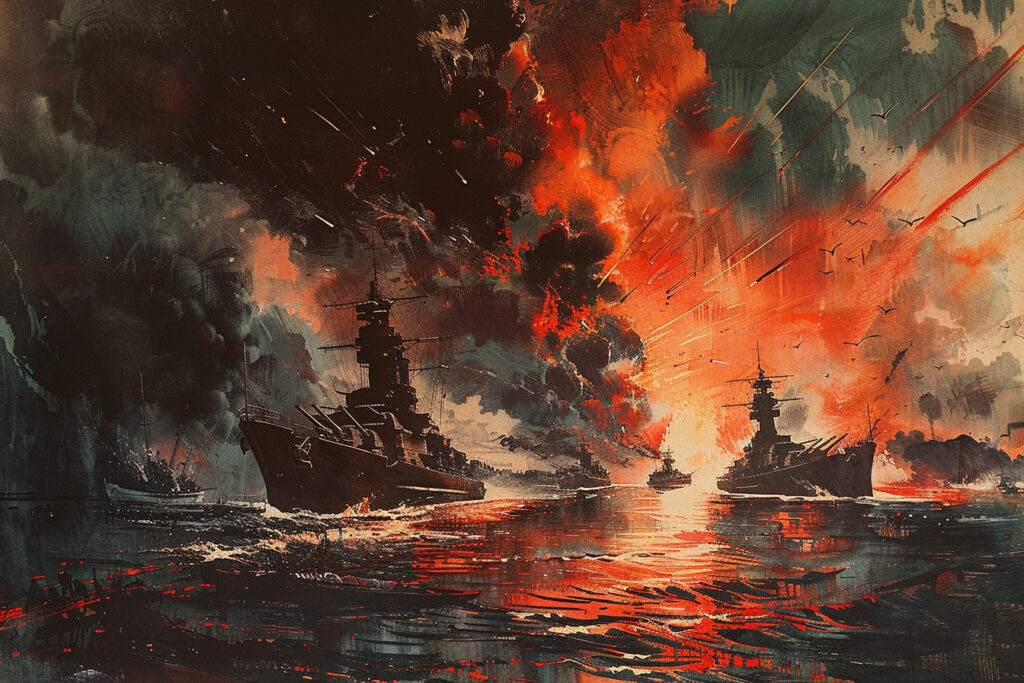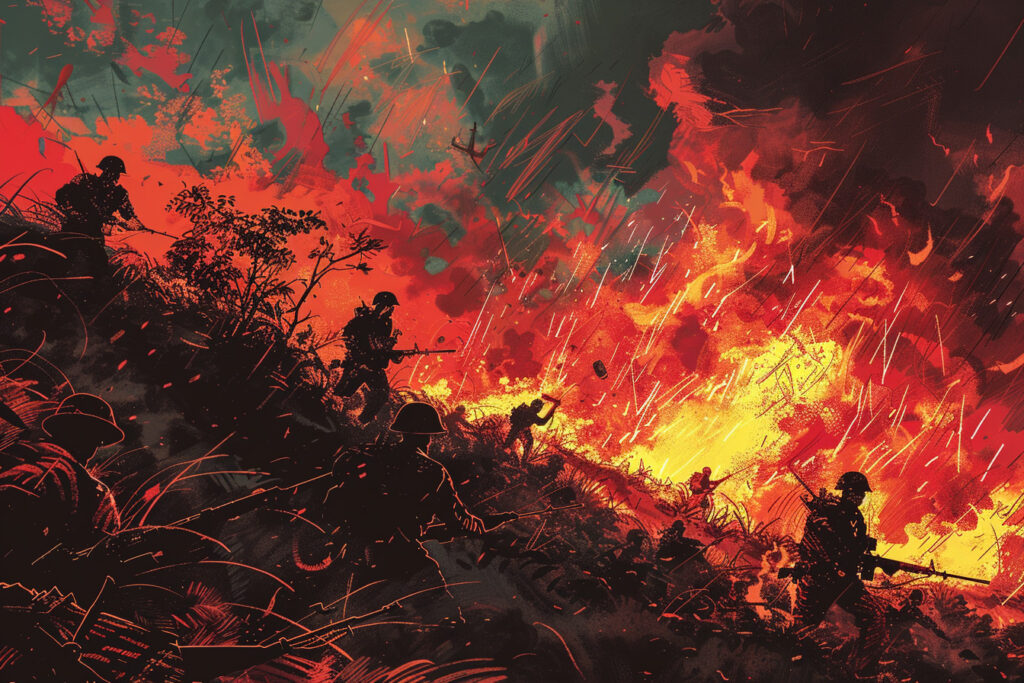The First Indochina War (1946-1954) was a conflict between France and Vietnamese communist-nationalist forces, leading to Vietnam’s independence.
The First Indochina War (1946-1954) marked a significant conflict between French colonial forces and Vietnamese communist-nationalist revolutionaries, primarily led by the Viet Minh. This war emerged in the wake of World War II, fundamentally reshaping Vietnam’s political landscape and setting the stage for further conflict in the region. It was a struggle for independence and control, deeply influenced by global Cold War dynamics.
Reasons for the First Indochina War (1946-1954)
The roots of the First Indochina War lay in the complex history of French colonialism in Vietnam and the rising tide of nationalist sentiment. France had colonized Vietnam in the mid-19th century, integrating it into French Indochina along with Laos and Cambodia. The Vietnamese population, subjected to economic exploitation and cultural domination, increasingly resented colonial rule.
During World War II, Japan occupied Vietnam, weakening French control and inadvertently fostering the growth of nationalist movements. The Viet Minh, led by Ho Chi Minh and the Communist Party, emerged as a significant force, capitalizing on anti-Japanese and anti-colonial sentiments. They sought independence and social reforms, gaining widespread support among the Vietnamese populace.
After Japan’s defeat in 1945, the Viet Minh seized the opportunity to declare independence, establishing the Democratic Republic of Vietnam on September 2, 1945. However, the French were determined to reassert their colonial control, leading to escalating tensions. Initial negotiations between the French and the Viet Minh failed, primarily due to conflicting visions for Vietnam’s future. The French sought to maintain Vietnam within their colonial empire, while the Viet Minh demanded full independence.
The failure of negotiations and a series of violent clashes culminated in the outbreak of full-scale war in December 1946. This conflict was driven by the Viet Minh’s determination to achieve independence and the French desire to restore their colonial dominance, compounded by the emerging Cold War context that saw both the United States and the Soviet Union interested in the outcome of the conflict.

Who Was Involved in the First Indochina War (1946-1954)
The First Indochina War involved several key parties, each playing crucial roles in the conflict’s progression and outcome.
France: The French colonial forces, initially confident of their ability to suppress the Viet Minh, faced a prolonged and challenging conflict. The French Foreign Legion, colonial troops, and metropolitan forces were involved, with significant financial and military support from the United States as part of its anti-communist strategy during the Cold War.
Viet Minh: Led by Ho Chi Minh and the Indochinese Communist Party, the Viet Minh was a coalition of various nationalist and communist groups. The organization had a well-organized guerrilla force that utilized hit-and-run tactics and knowledge of the local terrain to their advantage. They received support from China and the Soviet Union, particularly after the Chinese Revolution in 1949.
United States: Although not directly involved in combat, the U.S. provided substantial military and economic aid to the French. Viewing the conflict through the lens of the Cold War, the U.S. aimed to prevent the spread of communism in Southeast Asia.
China and the Soviet Union: Both communist powers provided support to the Viet Minh, offering military training, supplies, and strategic advice. This external support was critical for the Viet Minh’s sustained resistance and eventual success.
Local Populations: The Vietnamese civilian population played a significant role, with many providing support to the Viet Minh in various forms. The war also affected the broader population of Indochina, including Laos and Cambodia, which saw related conflicts and uprisings.
The involvement of these parties turned the First Indochina War into a significant conflict within the broader context of global Cold War politics, impacting strategies, alliances, and outcomes.
The Leaders of the First Indochina War (1946-1954)
Several key leaders shaped the course of the First Indochina War through their decisions and actions.
Ho Chi Minh: As the leader of the Viet Minh and the president of the Democratic Republic of Vietnam, Ho Chi Minh was the symbol of Vietnamese resistance against French colonial rule. His blend of nationalism and communism garnered broad support among the Vietnamese people. Ho Chi Minh’s leadership and political strategies were instrumental in sustaining the Viet Minh’s resistance and securing support from communist allies.
Vo Nguyen Giap: The chief military commander of the Viet Minh, Giap was a master strategist known for his use of guerrilla warfare and his ability to adapt conventional military tactics. Giap’s leadership in key battles, including the decisive Battle of Dien Bien Phu, was crucial to the Viet Minh’s success. He continued to play a prominent role in Vietnamese military strategy in subsequent conflicts.
Jean de Lattre de Tassigny: Appointed as the French High Commissioner and Commander-in-Chief in Indochina in 1950, de Lattre de Tassigny attempted to implement more effective military strategies and reforms to boost French efforts. Despite his efforts, including achieving some tactical successes, he could not turn the tide of the war in France’s favor.
Bao Dai: The last emperor of Vietnam, Bao Dai, was reinstated by the French as the head of the State of Vietnam, a French-controlled government. His leadership was largely symbolic and lacked popular support, diminishing his impact on the war.
These leaders significantly influenced the strategies, morale, and outcomes of the First Indochina War. Ho Chi Minh and Vo Nguyen Giap emerged as enduring symbols of Vietnamese resistance, while the French leaders struggled to maintain control over a determined and resilient opposition.
Was There a Decisive Moment
The decisive moment that escalated tensions into a full-scale war occurred in late 1946. On November 23, 1946, French naval vessels bombarded the northern port city of Haiphong, resulting in significant Vietnamese casualties. This incident dramatically heightened tensions and led to widespread anger and mobilization among the Vietnamese population. In response, the Viet Minh launched attacks on French positions in Hanoi on December 19, 1946, marking the beginning of the First Indochina War. These actions solidified the conflict, with both sides committing to a prolonged and bitter struggle for control over Vietnam.
Major Battles of the First Indochina War (1946-1954)
Battle of Hanoi (December 1946 – February 1947): The war began with Viet Minh forces attacking French positions in Hanoi on December 19, 1946. Despite initial successes, the Viet Minh were eventually forced to withdraw to the countryside. This battle marked the beginning of full-scale hostilities and demonstrated the Viet Minh’s commitment to armed resistance.
Battle of Haiphong (November 1946): Prior to the Battle of Hanoi, the French bombardment of Haiphong on November 23, 1946, resulted in thousands of Vietnamese casualties and escalated the conflict. This event catalyzed the outbreak of war, galvanizing Viet Minh resistance and deepening anti-French sentiment.
Operation Lea (October 1947): In an attempt to capture the Viet Minh leadership, French forces launched Operation Lea, targeting the Viet Bac region. While the operation inflicted heavy casualties on the Viet Minh, it failed to capture Ho Chi Minh or significantly weaken the resistance, showcasing the difficulties the French faced in countering guerrilla tactics.
Battle of Cao Bang (September – October 1950): The Viet Minh achieved a significant victory by ambushing and annihilating a French convoy attempting to withdraw from Cao Bang to Lang Son. This battle highlighted the growing strength and capability of the Viet Minh and led to the French reevaluating their strategy in northern Vietnam.
Battle of Na San (October – December 1952): The French attempted to replicate the success of the Viet Minh’s guerrilla tactics by establishing fortified positions in Na San. The Viet Minh launched several assaults but were repelled with heavy losses. Despite this, the battle showed the increasing boldness and capability of Viet Minh forces.
Battle of Dien Bien Phu (March – May 1954): The decisive and most famous battle of the First Indochina War, Dien Bien Phu saw General Vo Nguyen Giap orchestrating a siege against a fortified French base in a remote valley. The Viet Minh employed extensive trench warfare and artillery bombardments, gradually tightening the noose around the French garrison. The fall of Dien Bien Phu on May 7, 1954, marked the end of French colonial ambitions in Indochina and led directly to the Geneva Conference and the eventual partition of Vietnam.
These battles involved significant leaders such as General Vo Nguyen Giap for the Viet Minh and commanders like Jean de Lattre de Tassigny for the French. Each battle demonstrated the evolving tactics, resilience, and strategic acumen of the Viet Minh, contrasted with the increasingly desperate efforts of the French to maintain their colonial grip.
Was There a Turning Point
The turning point of the First Indochina War was the Battle of Dien Bien Phu. This battle demonstrated the effectiveness of Viet Minh tactics and their ability to besiege and defeat a well-fortified French garrison. The fall of Dien Bien Phu on May 7, 1954, not only marked a catastrophic military defeat for France but also shattered their will to continue the war. This decisive victory paved the way for the Geneva Accords, which led to the withdrawal of French forces from Indochina and set the stage for the eventual division of Vietnam.

Consequences of the First Indochina War (1946-1954)
The First Indochina War had profound consequences for the involved parties and the wider world. For Vietnam, the war led to the end of French colonial rule and the partition of the country into North and South Vietnam along the 17th parallel, as stipulated by the Geneva Accords. This division laid the groundwork for the Vietnam War, as ideological and political tensions between the communist north and the anti-communist south intensified.
For France, the war marked the end of its colonial empire in Southeast Asia. The heavy casualties and economic costs of the war contributed to political instability in France and diminished its global influence. The conflict also spurred decolonization movements in other French colonies.
Internationally, the war highlighted the growing intensity of the Cold War, with both the United States and the Soviet Union deeply invested in the conflict’s outcome. The U.S. viewed the French defeat as a significant setback in the struggle against communism, leading to increased American involvement in Vietnam and the broader region.
The Vietnamese population suffered immensely, with widespread destruction, loss of life, and displacement. The war’s legacy of division and conflict continued to affect Vietnam long after the French withdrawal, shaping the country’s future trajectory and its place in global geopolitics.
The First Indochina War was a crucial conflict that reshaped Vietnam and had lasting impacts on global politics. The war ended French colonial rule in Vietnam and set the stage for further conflict, culminating in the Vietnam War. The determination of the Viet Minh, the strategic failures of the French, and the international dimensions of the Cold War all played pivotal roles in the outcome of the conflict. The war’s legacy continues to influence Vietnam and its relations with the world today.
Back to the Wars section